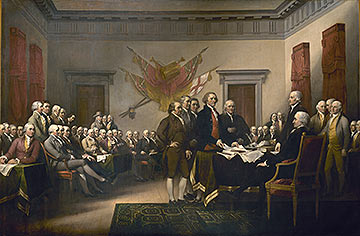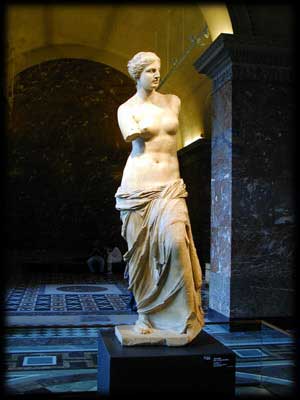Artist: John Trumball
Declaration of Indepenence - Year: 1819
 John Trumbull's Declaration of Independence is a 12-by-18-foot oil-on-canvas painting in the United States Capitol Rotunda that depicts the presentation of the draft of the Declaration of Independence to Congress. It was based on a much smaller version of the same scene, presently held by the Yale University Art Gallery.[1] Trumbull painted many of the figures in the picture from life and visited Independence Hall as well to depict the chamber where the Second Continental Congress met. The oil-on-canvas work was commissioned in 1817, purchased in 1819, and placed in the rotunda in 1826.
The painting is often described as the "Signing of the Declaration of Independence", but this is an error. The painting actually shows the five-man drafting committee presenting their draft, an event that took place on June 28, 1776, and not the signing of the document, which took place later.[2]
The painting shows 42 of the 56 signers of the Declaration; Trumbull originally intended to include all 56 signers, but was unable to obtain likenesses for all of them. He also decided to depict several participants in the debate who did not sign the document, including John Dickinson, who declined to sign. Because the Declaration was debated and signed over a period of time when membership in Congress changed, the men in the painting had never all been in the same room at the same time.
Thomas Jefferson seems to be stepping on the foot of John Adams in the painting, which many think is supposed to symbolize their relationship as political enemies. However, upon closer examination of the painting, it can be seen that their feet are merely close together. This part of the image was correctly depicted on the two-dollar bill version.
John Trumbull's Declaration of Independence is a 12-by-18-foot oil-on-canvas painting in the United States Capitol Rotunda that depicts the presentation of the draft of the Declaration of Independence to Congress. It was based on a much smaller version of the same scene, presently held by the Yale University Art Gallery.[1] Trumbull painted many of the figures in the picture from life and visited Independence Hall as well to depict the chamber where the Second Continental Congress met. The oil-on-canvas work was commissioned in 1817, purchased in 1819, and placed in the rotunda in 1826.
The painting is often described as the "Signing of the Declaration of Independence", but this is an error. The painting actually shows the five-man drafting committee presenting their draft, an event that took place on June 28, 1776, and not the signing of the document, which took place later.[2]
The painting shows 42 of the 56 signers of the Declaration; Trumbull originally intended to include all 56 signers, but was unable to obtain likenesses for all of them. He also decided to depict several participants in the debate who did not sign the document, including John Dickinson, who declined to sign. Because the Declaration was debated and signed over a period of time when membership in Congress changed, the men in the painting had never all been in the same room at the same time.
Thomas Jefferson seems to be stepping on the foot of John Adams in the painting, which many think is supposed to symbolize their relationship as political enemies. However, upon closer examination of the painting, it can be seen that their feet are merely close together. This part of the image was correctly depicted on the two-dollar bill version.

Discovery of Venus de Milo
Artist: Alexandros of Antioch - Year: 1820
 Venus de Milo, is an ancient Greek statue and one of the most famous works of ancient Greek sculpture. Created at some time between 130 and 100 BCE, it is believed to depict Aphrodite (Venus to the Romans) the Greek goddess of love and beauty. It is a marble sculpture, slightly larger than life size at 203 cm (6 ft 8 in) high. Its arms and original plinth have been lost. From an inscription that was on its plinth, it is thought to be the work of Alexandros of Antioch; it was earlier mistakenly attributed to the master sculptor Praxiteles. It is at present on display at the Louvre Museum in Paris.
Venus de Milo, is an ancient Greek statue and one of the most famous works of ancient Greek sculpture. Created at some time between 130 and 100 BCE, it is believed to depict Aphrodite (Venus to the Romans) the Greek goddess of love and beauty. It is a marble sculpture, slightly larger than life size at 203 cm (6 ft 8 in) high. Its arms and original plinth have been lost. From an inscription that was on its plinth, it is thought to be the work of Alexandros of Antioch; it was earlier mistakenly attributed to the master sculptor Praxiteles. It is at present on display at the Louvre Museum in Paris.
The Aphrodite of Milos was discovered by a peasant named Yorgos Kentrotas on April 8, 1820, inside a buried niche within the ancient city ruins of Milos, on the Aegean island of Milos (also Melos, or Milo). The statue was found in two main pieces (the upper torso and the lower draped legs) along with several herms (pillars topped with heads).